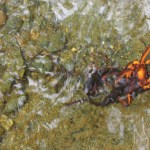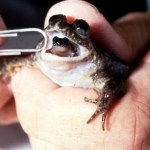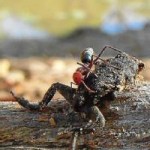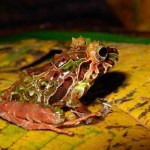amphibian
With springtime comes the urge to head to the river. These California newts are obeying urges of their own. Also known as Taricha torosa, this newt is an amphibian and a member of the Salamander family.
Just as beautiful as the newts is the surface of the water. I wish I could breathe under water!
I counted more than a hundred of these along a small creek that flows into the Yuba river. According to Wikipedia, these animals are land-dwelling for the hotter parts of the year, but prefer "slow-moving water" while breeding. Between December and May, they can…
Birth of the Gastric Brooding Frog
Photo Mike Tyler
Unfortunately, species are the ultimate bioephemera.
Amphibians in particular have been declining at an alarming rate over the past several decades; some estimates suggest that a third of amphibian species are on the verge of extinction. My latest essay for SEED's website opens with the story of the Gastric Brooding Frog, Rheobatrachus silus, an extremely peculiar species. It was discovered in the 1970s, and already believed extinct just over a decade later. That's barely enough time to describe a species, much less save it.
Save the Frogs…
In the 1930s, Australian ecologists shortsightedly introduced the Cane Toad, a species indigenous to South America, to their isolated continent to eat agricultural pests. This famously proved to be a complete disaster with the toxic toads running rampant and native species poisoning themselves when they tried to make snacks of the delicious, dimwitted amphibians.
Now a team of Australian researchers from the University of Sydney think they may have found an elegant solution that absolutely, positively, cannot backfire into a 1970 C minus horror movie: Meat Ants. The gentle meat ant lives…
Researchers in a remote Colombian jungle have identified 10 new species of amphibian. Keeping with Zooillogix's official policy, because the creatures are finally known to Western science, now and only now can we all consider them to exist. Scientists from Conservation International and the Ecotropico Foundation explored the mountains in the Tacarcuna area of the Darien near Panama to discover the new species.
Oranged-legged rain frog
Many more below the fold...
Another kind of rain frog
Salamander Bolitoglossa taylori
Poisonous frog of the Dendrobatidae famlily
Glass frog of the…
A quick wrap-up of the animals discovered not to be extinct this week:
Armoured mistfrog
This Armoured Mistfrog, thought by many experts to be extinct due to the recent amphibian chytrid fungus epidemic, was rediscovered by my boss, enterprise search god, Chris Cleveland, while he should have been working, on CNN. And more specifically, in a remote tropical area in northern Australia.
Tadpole Shrimp
Heavy rains in Scotland have created perfect conditions for the reemergence of the tadpole shrimp, thought extinct in the UK until recently. The little critter resembles a tiny horseshoe crab…
"Toad licking" has been well documented around the world with secretions from many species causing intense hallucinations. In this 2006 NPR podcast, they tell the story of a poor cocker spaniel who became addicted to toad. "We noticed Lady (the cocker) spending an awful lot of time down by the pond in our backyard. Late one night after I'd put the dogs out, Lady wouldn't come in. She finally staggered over to me from the cattails. She looked up at me, leaned her head over and opened her mouth like she was going to throw up, and out plopped this disgusting toad." Increasingly Lady would return…
A study of rare African frogs has revealed a form of self-defense hitherto unbeknownst to the scientific world: claws of pure bone that burst through the frogs' skin. And it gets worse. When the frogs are threatened they need to first "actively break" their own bones in order to create these claws.
Don't make me angry...you wouldn't like me when I'm angry.
David Blackburn of Harvard's Museum of Comparative Zoology released his team's findings last week in Biology Letters on the Trichobatrachus robustus, and ten other related species of frog, most of which live in Cameroon.
The frogs'…
Adorable!
Surinam toads of the family Pipidae have a broad, flat shape and leaf-like appearance, but who cares about that...? They embed fertilized eggs in the mother's back from whence the babies emerge! Adorable? Horrifying? What was your reaction to the movie Alien?
Damn... it looks like Pharyngula beat us to the punch. Whatevs... Surinam Toad stays.
tags: Amphibian, photography, subway art, AMNH, NYC, NYCLife
I think this is a caecelian with eggs
as portrayed in tiles on the walls of the NYC uptown-bound subway stop (A-B-C)
at 81st and Central Park West. (ISO, no zoom, no flash).
Image: GrrlScientist 2008. [wallpaper size].
Read more about the AMNH tile artworks and see the AMNH tile artworks photographic archives -- with all the animals identified.
Scientists in Madagascar recently discovered the remains of a giant prehistoric frog, a relative of today's horned toads, which blew away the previous record for the largest known frog, Bennicus Bleimanicus. Dubbed Beelzebufo, meaning "frog from hell," the Devil Frog had important differences from today's frogs. To begin with, it was freakin huge. Susan Evans, a researcher from the University College of London, explained that if it was anything like its closest living forebears, "it would have been quite mean." Considering the fact that it was "the size of a slightly squashed beach-ball,…
We know this story has been covered by everyone from LiveScience to Perez Hilton, but we thought we'd do our part as well to promote awareness.
Chinese giant salamander....very tasty.
An initiative known as EDGE (Excited Dachshunds Grinding with the Elderly) has released its list of unique and critically endangered amphibians, hot on the heels of their steamy, after hours EDGE Mammals edition.
The initiative is a part of the...
...Zoological Society of London, who made the announcement yesterday. The endangered amphibians come in all shapes and sizes from the giant salamanders of China to…
An international consortium of zoos, aquariums, conservation organizations and scientists, calling itself the "Amphibian Ark," has dubbed 2008 the "Year of the Frog." Amphibian Ark made the declaration in order to draw awareness to the mass extinction of amphibian species around the globe and to infuriate the Chinese, who already named the year after the rat "like 5000 years ago". The AArk is a joint effort of 3 principal partners: the World Association of Zoos and Aquariums (WAZA), the IUCN/SSC Conservation Breeding Specialist Group (CBSG), and the IUCN/SSC Amphibian Specialist Group (ASG…
Reported last month in the journal Proceedings of the Royal Society B, a fascinating fossil was discovered in the Saar-Nahe Basin of Southwestern Germany (sounds more like somewhere in Middle-earth than Bavaria to us, but go figure). The fossil(s?) comprises a fish that was eaten by an amphibian which was eaten by a shark. It is being described as the oldest snapshot of the vertebrate food chain and represents, if nothing else, some good eatin'.
In case you couldn't visualize it, this last graphic is an EXACT snapshot of what this prehistoric brunch orgy looked like...
The shark lived in…
We get a lot of requests to feature friends pets on Zooillogix. Some people just don't seem to get the fact that their golden retriever does not belong on a site devoted to bizarre zoology (you know who you are Mike Tippet of 2 Third St., Farfield, CT). However, Jennifer's axolotl, Big Ben, is a welcome guest.
Axolotl's are Mexican neotenic mole salamanders, which fail to go through metamorphosis as larvae and therefore retain their gills and aquatic nature. The axolotl was native to Lake Xochimilco and Lake Chalco in central Mexico, the latter of which no longer exists. However, lucky (?)…
Those crazy Japanese have done it again! By combining two types of recessive genes that cause frogs to be pale, they have created a frog with almost transparent skin. Unfortunately for the frogs, the advantages to testing on a see-through critter are numerous. For example, "You can see through the skin how organs grow, how cancer starts and develops," explained the lead researcher Masayuki Sumida, professor at the Institute for Amphibian Biology of state-run Hiroshima University. "You can watch organs of the same frog over its entire life as you don't have to dissect it. The researcher can…
Hey there, ladies. I'm just a lonesome, evolutionary mishap who loves to party.
The Purple frog or Nasikabatrachus sahyadrensis can be described as a "living fossil." These strange creatures split evolutionarily from other frogs nearly 150 million years ago giving them features unique to any amphibian, so unique in fact that they have been put in their own taxonomic family. Purple frogs were officially discovered by scientists in 2003 in the hilly jungles of Western India. Making them particularly difficult to locate is their propensity for burrowing deep in the jungle floor and only…
A team of Florida International University zoologists studying poison arrow frogs in South America have identified the source of the colorful critters' toxicity. Researchers have long known that the amphibians do not produce the toxic compounds, alkaloids, themselves, but were uncertain of their origins. The FIU team discovered that the frogs were eating tiny oribatid mites that are abundant in decaying plant matter. Analysis of the mites determined over 80 types of alkaloids present in their tiny bodies, explaining the source of the frogs' defense.Come on... just one quick taste... all the…
"This bounty hunter is my kind of scum: fearless and inventive." Cane toad, Bufo marinus
The environmental group, Frogwatch, caught one of the largest specimens of toad ever discovered in Darwin, Australia on Tuesday. The apprehended toad is the size of a football and as heavy as a small sack of potatoes.
Cane toads are a highly poisonous, non-native species in Australia and have been wreaking havoc on the local ecosystem for decades. Frogwatch's "Toad Buster" project launches "raids" on small ponds, blinds the toads with bright lights and nets them by the dozens. From there they are killed…



